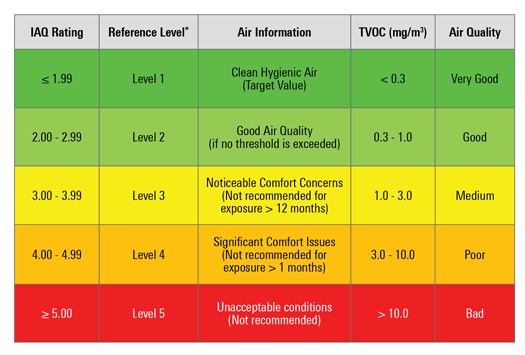We spend 90% of our time indoors where harmful gasses often go unnoticed. Remote air quality sensors can be used to help ensure individuals have quality air for their health and well-being.

Understanding our environmental conditions has become an important consideration these days as we are all spending much more time indoors, whether working from home or just not getting out as much as we had been. Inside our homes, we have varying levels of total volatile organic compounds (TVOCs) as well as elevated levels of carbon dioxide (CO2). These gasses can sometimes increase in concentration and become irritants, with some being carcinogens that are harmful to the body. While some of these gasses can be detected from smell, many, such as formaldehyde, are difficult to detect due to its pickle-like, or lack of, odor.
Understanding these gasses, as well as the sources and remediation options to eliminate harmful concentrations are available today. Today’s air quality systems can monitor and provide warnings from a smartphone application and adjust the HVAC systems and air purifiers to bring the unhealthy gasses back to a healthy level. Many of these systems can act on our behalf without user involvement.


One air quality sensor and system deployment barrier that has now been overcome is the usage of ultra-low power (ULP) sensors. With the release of firmware configurable hardware, such as Renesas’ ZMOD4410, the sensor can change the firmware to run in a ULP mode consuming less than 160µW of power. This sensor can be run for months or years on AA batteries and detect harmful VOCs that are reported through a defined UBA scale as well as estimate CO2 levels.
The firmware utilizes a neural network training approach with millions of data points and is then integrated into an embedded artificial intelligence sequence that optimizes sensor performance. In the case of the new ultra-low power indoor air quality (IAQ) firmware, a short duty cycle is used with a sweeping technique, leveraging temperature and time that identifies signatures that are specific to air quality.
What this means to our customers is all of the development work has been completed offering product development companies pre-calibrated sensor and firmware libraries that are easily integrated into the host microcontroller. Products that require battery operation such as remote thermostats, environmental sensing hubs, remote IAQ monitors, smoke detectors, and wearable devices can download and use the new ULP firmware library to meet their specific application requirements. Sensors can now be deployed to every room in the building whether AC power is conveniently available or not.
With battery-operated units that communicate to users, the cloud or HVAC systems, deployment can be realized in minutes without the need for expensive integration experts. Systems will utilize ultra-low power MCUs, humidity sensors and connectivity solutions that provide for long life before the need to change batteries.
Our homes and offices are now readily deployable with indoor air quality sensors and are truly looking after our health and well-being with flexible firmware configurable architectures and systems designed for battery operation.
